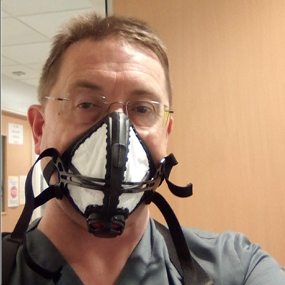Anaesthesia and COVID-19 one year on: My story

Dr James Watts is a consultant in anaesthesia and critical care medicine at the East Lancashire Hospitals NHS Trust
We were fortunate in that there was a short time lag between COVID-19 appearing in the UK and arriving in East Lancashire. The time was used to train staff, and formulate our strategy, including our escalation plan which included expanding our 24 ITU beds into a bed base of up to 160 if necessary.
As this was a new virus, which no one knew how to treat, in the early days the strategy was for early full ventilation under anaesthetic. I intubated our hospital’s first suspected case - a hot, sweaty and awkward affair in full PPE. Back then at the start of the pandemic, it was taking so long to get test results back, that by the time we found out the patient was negative, he had thankfully recovered and gone to the ward.
Rapidly, our entire expanded bed base became full, but fortunately we had excellent assistance from our anaesthetic and theatre colleagues, and from the many trainee doctors and student nurses who were seconded to us. The trainee doctors found themselves assigned to roles they had not been expecting, such as working for a few months on the ITU, dealing with very sick patients, irrespective of their starting specialty.
With the help of our anaesthetic colleagues, we were able to create specialist emergency teams to deal with respiratory emergencies all over the hospital and to create ‘proning’ services. This was in addition to maintaining the integrity of other services, such as obstetric anaesthesia.
In April, I caught COVID-19 and was off work for a month, returning when the fatigue and shortness of breath were not too bad. Sadly, this was just in time for the peak of the first wave of cases. Eventually, the number of cases fell, and some degree of normality began to return as we were able to re-escalate our commitment to complex elective work. However, having two workstreams – COVID-19 and non-COVID-19 patients – created unique logistical issues. In practice, operating theatres and wards had to be duplicated, with consequences for capacity and staffing.
In Lancashire as a whole, we only had a brief respite at the end of summer and cases started to climb from September. By November, cases were starting to escalate rapidly again, but we realised that we were ahead of the curve this time.
The rapid spread was overwhelming, and without the ability to provide large amounts of oxygen under positive pressure or at very high flow rates, most patients admitted would have died. Never in 30 years of practice have I faced a situation where we were concerned that we might run out of oxygen. I hope to never be in another one.
We developed better strategies for communicating with relatives, and for combatting the unhelpful rumours and conspiracy theories about treatment that circulated in the community. It was disheartening to hear COVID-19 referred to as a ‘minor illness’ with ‘low mortality’ and ‘no worse than flu’ on social media, in the press and out in the real world.
To maximise our flexibility, approach and systems, my colleagues played to their strengths. Some made innovative improvements to clinical care, some ran the various COVID-19 research programmes, others maintained the teaching requirements and others arranged support for staff wellbeing. I personally was able to participate in the NICE rapid evidence reviews for various COVID-19 treatment proposals.
With our acute care team and consultant colleagues, we were able to create an enhanced respiratory area for patients who needed ‘ward+’ level care. This new area was able to accommodate an extra eight patients who would otherwise require admission to ITU, relieving strain on our bed capacity.
We learnt how to identify, access and develop current wellbeing services, and also how to book appointments with Jasper the therapy dog (who was later invited with his owner to turn on the lights at Blackpool).
We also learnt a new term – decompression transfer – the regional (and sometimes nationwide) coordination of ITU resources that included the moving of patients from one unit under high pressure to units under lesser pressure to maintain the whole service. Some of us were able to resurrect, and pass on, our long dormant transfer skills. To put this in some context, in the six years prior to 2020, we transferred only one patient for lack of general ITU capacity. In January 2021, we transferred over 30.
As I write this, in February 2021, we now have signs that the winter peak may start to recede, and NHS staff - and the wider population - are now being vaccinated. We are hopeful that the pandemic will become more manageable, at least for the time being. Hopefully, we will have time to reflect and recover as normal service is resumed, although how quickly that will occur is open to discussion.
To find out more about the role of anaesthetist during COVID-19 visit this College webpage.
Dr James Watts
